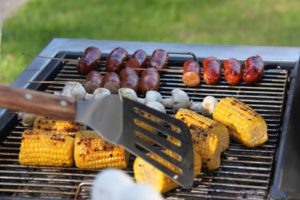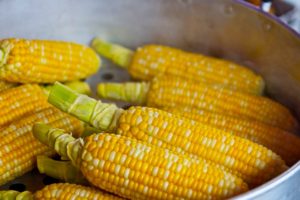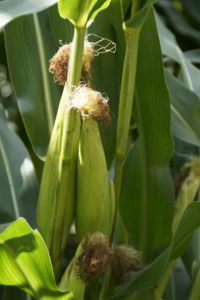 Summer cookouts would not be quite so sweet without sweet corn! Standard sweet corn varieties contain a “sugary gene” that is responsible for the sweetness and creamy texture of the kernels. Sweet corn is best suited to being picked, husked, and eaten within a very short time, so avoid the temptation to buy more than you need.
Summer cookouts would not be quite so sweet without sweet corn! Standard sweet corn varieties contain a “sugary gene” that is responsible for the sweetness and creamy texture of the kernels. Sweet corn is best suited to being picked, husked, and eaten within a very short time, so avoid the temptation to buy more than you need.
Health Benefits
Some of the pleasure that comes from eating corn on the cob or a bowl of popcorn comes from the satisfaction of feeling full. Corn fiber promotes satiety and helps to keep the intestinal track running smoothly. Recent research has also shown that consuming corn supports the growth of friendly bacteria in our large intestine. In addition to providing 10% of the daily recommended intake of fiber per cup, sweet corn is also sodium-free, low in fat, and a source of vitamin A and C.
Selection & Storage of Sweet Corn
- Choose sweet corn with husks that are tightly folded and green, and tassels that are brown and sticky. Tassels will dry and darken with age. Feel each ear gently through the husk without peeling it to check for even, plump kernels.
- Storing sweet corn degrades quality, and after only a few hours at room temperature, sugars can start turning to starch, causing loss of flavor and overall sweetness.
- To store sweet corn, use perforated plastic bags or a brown paper bag and refrigerate as soon as possible. Try to use the corn within 1 to 2 days and do not husk until just prior to cooking.
Preparation
Corn can be prepared in a number of ways, depending on your time and preference:
 To grill:
To grill:
- Place husked corn on the grill, close the cover and grill for 15 to 20 minutes, turning every 5 minutes, or until kernels are tender when pierced with a paring knife.
-or-
- Place corn in the husk on the grill, and cook, turning occasionally, about 15 minutes. The outside should be completely black, but the interior should be steamed and moist. Let the corn cool slightly, pull back the husk and silk, and serve.
To boil:
-
Choose a pot large enough to hold the amount of corn you want to cook, with room for water to cover the corn. Cover pot and bring water just to a boil on high heat.
-
Add husked corn ears and bring the water back to a boil on high heat. Once water comes back to a boil, immediately remove the corn ears from the water. Drain well and serve.
To microwave:
- Place 2 to 3 ears of husked corn in a microwave-safe dish with 2 tablespoons of water and cover. Microwave on high 4-6 minutes
-or-
- Place 2 ears of corn in the husk on a plate in the microwave and microwave on high 8 minutes. Let cool slightly or use a hot mitt to remove husks; serve.
To eat raw:
- Husk corn. Wash under cold water. To remove the corn kernels, place the ear of corn on a cutting board, stem side down. Hold the top of the corn firmly and with a sharp knife, cut kernels from the cob away from your hand and onto the board. Add to salads and side dishes.
 Colorado Corn
Colorado Corn
The best is yet to come! Harvested and shipped mid-July through mid-October, Colorado is well known for producing some of the best sweet corn in the United States. Our unique growing climate and soil types combined with innovative farming practices ensure consistent quality and superior taste.
- Find where Colorado corn and other produce is grown and available in 2018 in the Colorado Farm Fresh Directory
- Learn more about Colorado corn and get a recipe for Grilled Mexican Corn.
- Consider preserving some sweet corn. Use CSU’s new Preserve Smart app and website for instructions for canning, freezing, and drying corn!


Delicious !!!!!
I can’t wait for Colorado corn to arrive in my market! I’ve never tried microwaving in the husk, but will definitely try it this summer. Thanks for the corn preparation ideas.
Sheila,
So glad you enjoyed the post! Let me know how you like the microwaved corn in the husk!!